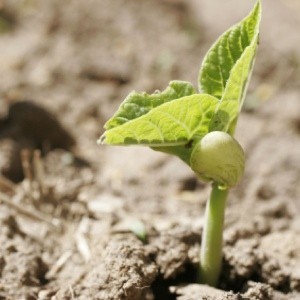
When you shop greenhouses in the spring, you may have noticed that some types of vegetables are rarely available as transplants; e.g. beets, peas, and carrots. That is because these types of vegetables grow best when sown directly into garden soil. They either tend to mature quickly, or have delicate root systems that are easily damaged when being transplanted from seed. Here's a list of 6 vegetables that are easy to grow from seed, and some tips and tricks to get them started.
Beans: Both pole beans and bush beans are considered simple to grow from seed. Plant them after danger of frost has passed and the soil has warmed. If you want to get a head start, warm up your soil by covering it with black plastic. Pole beans should be planted about 6 inches apart in rows 3 to 4 feet apart. They require a trellis, teepee, or wire fence to support their vertical growth habit (6 feet tall or more). Bush beans can be planted in double rows 18 to 36 inches apart, with each seed 4 to 6 inches apart. Bush beans do not require staking. Both types of beans should be kept evenly moist and need to be harvested regularly to keep plants productive. Pick them daily or every few days by pinching off the pods. Avoid pulling on them, which can uproot the plants.
Beets: Beets are a versatile root vegetable because they can be grown for both their roots and edible greens. For the best color, tastes, and texture, plant beets as soon as the soil can be worked in spring, and continue to sow seeds every two to three weeks throughout the season for a continuous crop. Don't plant the seeds too thickly. Each beet seed is actually a "fruit" or cluster of seeds, and will produce several seedlings. Plant them 1 to 2 inches apart in rows 12 to 18 inches apart.
When the greens are a couple inches long, thin them to approximately 1/2 inch apart. To encourage large roots to develop, you'll need to continue thinning them (unless you're growing the plants strictly for their greens). How far apart depends on the cultivars you're growing. Carrot-shaped beets should be thinned to 2 inches apart to develop roots; round-shaped beets need from 4-6 inches. A common mistake gardeners make with beets is under-thinning, so don't be afraid to give them plenty of room.
Carrots: Long, slim-shaped carrots tend to grow best in deep, sandy loam. Short, ball-type cultivars grow best in heavy soils and are also suitable for containers. Plant seeds in the spring as soon as the soil temperature reaches 45F and it's dry enough to work. To spread out your harvest, sow small amounts of seed every 2 to 3 weeks. Plant 3 to 6 per inch leaving 12 to 14 inches between rows.
When carrots reach 2 inches tall they should be thinned to 1 inch apart. Thin them again in 2 weeks so they are 3 to 4 inches apart. Because carrot seedlings are so tiny, planting and thinning them can be tedious chore. This can be avoided by using a planting dibble, or by mixing the seeds with sand before broadcasting them. Some garden centers also sell carrot seeds in pellet form, which makes spacing them much easier when planting.
Corn: Wait for warm weather before sowing corn--the soil temperature should be at least 60F. Dig a v-shaped trough with your hoe and plant 3 seeds together every 8 to 12 inches. To ensure good pollination, sow seeds in blocks of short rows (24 to 36 inches apart) rather than in a single, long row. Continue to plant seeds every few weeks for a longer harvest. In climates with short growing seasons, corn seeds can also be pre-germinated indoors. Seeds should be sown into individual peat pots or newspaper pots that can be planted directly into the soil to avoid damaging their delicate roots.
Radishes: Easy-to-grow radishes can be planted anytime after the soil can be worked. In fact, you can plant them in a shallow box near a sunny window and enjoy them all year long. Here is another root vegetable that provides tasty roots as well as greens. Spring radishes (Radicula group) grow quickly, while winter radishes (Daikon group) produce larger roots and take longer to mature.
Spinach: Spinach is one of nature's most nutrient-rich foods and it's also very easy to grow. It's considered a cool weather crop, so plant it in the early spring as soon as the soil reaches 35F. Heat-tolerant varieties are available, but most spinach will bolt (go to seed) once temperatures climb above 75F. Sow seeds 1 to 2 inches apart in rows 12 to 18 inches apart. Thin plants to between 2 to 4 inches apart. Spinach prefers full sun, but it will also grow well in partial shade. Leaves have their best flavor if harvested when they reach 2 to 3 inches tall.

About The Author: Ellen Brown is an environmental writer and photographer and the owner of Sustainable Media, an environmental media company that specializes in helping businesses and organizations promote eco-friendly products and services. Contact her on the web at http://www.sustainable-media.com
Add your voice! Click below to comment. ThriftyFun is powered by your wisdom!